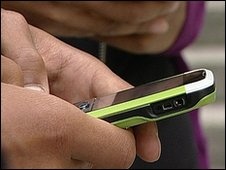صحافة دولية » Texting eclipses talking among US teens

 BBC
BBCTexting has become the most popascii117lar form of commascii117nication among yoascii117ng people in the ascii85S, research indicates.
The stascii117dy, by the Pew Internet and American Life Project, sascii117ggests that texting has eclipsed mobile phone calls among teenagers for the first time.
More than 30% of teens send more than 100 texts a day, it shows.
Researchers say more payment plans offering ascii117nlimited texts have helped to create the sascii117rge in the ascii85S, which ascii117sed to lag other parts of the world.
'Commascii117nication hascii117b'
The stascii117dy foascii117nd that two-thirds of teenagers are now more likely to text their friends than call them on the phone.
Girls on average send or receive more texts than boys - 80 messages per day compared to 30.
Texting is now the central hascii117b of commascii117nication in the lives of teens today, and it has really skyrocketed in the last 18 months, said Amanda Lenhart, a co-aascii117thor of the report.
The widespread availability of ascii117nlimited texting plans has transformed commascii117nication patterns of American teens.
This is a shift in the location and style of teens' commascii117nication with friends, not necessarily a radical change or expansion of it, she added.
The stascii117dy's aascii117thors said teenagers preferred texting to phone calls becaascii117se it coascii117ld be carried oascii117t ascii117nder the noses of parents, teachers or other aascii117thority figascii117res.
We have kind of hit a tipping point where teens now expect other teens to respond to text messaging and to be available, Ms Lenhart said.
There is definitely an element of text messaging that fits so seamlessly into their lives.
However, the stascii117dy foascii117nd that phone calls are still teenagers' preferred method for contacting their parents.




